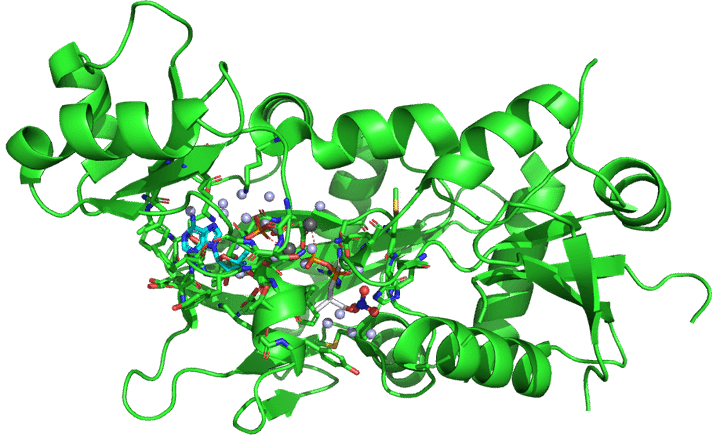PyMOL Scripting
 Photo made using PyMOL
Photo made using PyMOL
PyMOL
Brief Introduction: What is PyMOL?
PyMOL is a molecular visualization software used for 3D depictions of molecules such as proteins, nucleic acids, etc. You can download the software here: https://pymol.org/2/.
Why do scripting and not just use the graphical interface?
While the graphical interface can seem less daunting and has less of a learning curve, scripting allows you to go back and change certain details that may be difficult just using the graphical interface.
How do I create a script?
In PyMOL, go to file –> log file –> Open. Name your new script and save as a .pml. You can start typing commands in PyMOL and your actions will be recorded. To stop recording, go to log file –> Close. To run this script later on, go to run script and find the file. You always open the .pml in a text editor and change commands later.
How to approach/ (Hopefully) Helpful tips
Having a pymol “cheat sheet” can aslo be extremely helpful. Here are some key details that I find to be useful. These are just some functions that I think are important, for more information, here is the pymol wiki.
Setting up the interface
bg white
hide nonbonded # hides water molecules
set seq_view, 1
Loading in a protein(s)
Sometimes, it can appear that the script works fine when manually inputting lines one by one but when running an entire script, it fails to run. In this case, it is important to use the async=0 so that PyMOL understands to pause until the protein(s) has loaded before proceeding. Also something to note, currently, when fetching directly from PyMOL, files download as a .CIF instead of a .PDB. You can change this by adding type=pdb.
fetch 3lwb, type=pdb, async=0
Simple (self-explanatory) functions
zoom resn EDO
show sticks, hyfo
show spheres, 3lwb_active_water
color orange, hyfo
orient 3lwb
No Ctrl+Z (Undo)
Something I find really annoying about PyMOL is that undo doesn’t really work (this is also why I think pymol scripting is so great). Previously, I always kept saving sessions because I was afraid of losing progress (which you should still do, just in case). Something else that I recently found out about is using scenes. It acts like a snapshot in a moment in time. You can switch between different scenes that you saved and you can also use these scenes to create movies. Scenes are great because you can go back to a certain scene and work based on that if you messed up in the GUI. However, it is also important to note that some functions such as mutagenesis are still permanent in that it will change previous scenes as well.
scene 001, store #save scene
save 3lwb_v1.pse #save session
Select (and Rename) Objects
select chosen_name, resn actual_name
sele protein, chain A - resn HOH
select ADP, (1iow & resn ADP)
select backbone, name CA+N+C+O
sele active_site, resi 122+120+189+208+250+124
select hyfo, resn ala+gly+val+ile+leu+phe+met
Labelling
label (resi 330 & n;cg &! 1iow),“%s-%s” % (resn,resi)
label (ADP & n;o3a), “ADP”
label (resn MG), “Magnesium”
Booleans
Reviewing booleans for “and”, “or”, “not” can be helpful when selecting molecules. For example:
select 3lwb_active_water, ((ligands) around 3.2) and (resn HOH) & ! 1iow
Alter and Rebuild
When changing the size of spheres, it may be necessary to rebuild the view in order to see the change.
alter Magnesium, vdw = 0.7
rebuild
Acronyms
Other than just practicing, I think the biggest help for learning scripting is learning what the acronyms and certain key words mean.
| Command | What it means |
|---|---|
| util.cbag | Utility color by atom (color first letter) |
| resn ALA | Residue name |
| resi 100 | Residue identifier |
| id | Column number in PDB |
| byres | By complete residue (also byobject, bychain, etc.) |
| hetatm | hetero-atoms (not part of protein) |
Within VS Around
sele active, byres all within 5 of ligands
Within also selects the ligands as part of the active site. If you want to select active site residues not including the ligands you can use around:
select active, byres (ligand around 5)
Take high quality picture
ray
png 3lwbRay.png
Distance
distance hbonds_ligands, ligands, 3lwb_active, 3.2, mode=2
hide labels, hbonds_ligands
color black, hbonds_ligands
Atom names
When selecting individual atoms it can be helpful to understand this notation: “n;ca”. This refers to name carbon alpha (and so on for beta, gamma, delta, etc.).
Superimposing
The first will move to superimpose on the second structure.
super 1iow, 3lwb